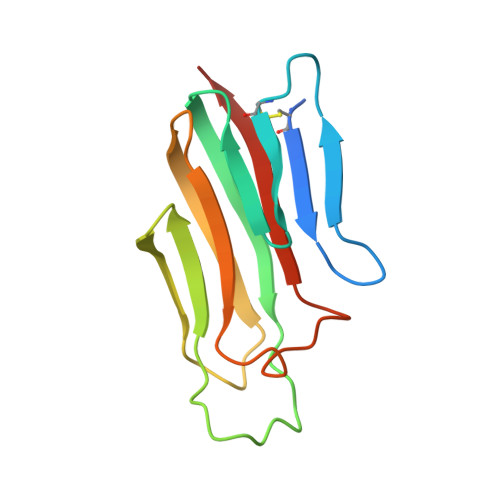Assembly and structural properties of glucocorticoid-induced TNF receptor ligand: Implications for function.
Chattopadhyay, K., Ramagopal, U.A., Mukhopadhaya, A., Malashkevich, V.N., Dilorenzo, T.P., Brenowitz, M., Nathenson, S.G., Almo, S.C.(2007) Proc Natl Acad Sci U S A 104: 19452-19457
- PubMed: 18040044
- DOI: https://doi.org/10.1073/pnas.0709264104
- Primary Citation of Related Structures:
2Q1M, 2R30, 2R32 - PubMed Abstract:
Glucocorticoid-induced TNF receptor ligand (GITRL), a recently identified member of the TNF family, binds to its receptor GITR on both effector and regulatory T cells and generates positive costimulatory signals implicated in a wide range of T cell functions. Structural analysis reveals that the human GITRL (hGITRL) ectodomain self-assembles into an atypical expanded homotrimer with sparse monomer-monomer interfaces. Consistent with the small intersubunit interfaces, hGITRL exhibits a relatively weak tendency to trimerize in solution and displays a monomer-trimer equilibrium not reported for other TNF family members. This unique assembly behavior has direct implications for hGITRL-GITR signaling, because enforced trimerization of soluble hGITRL ectodomain results in an approximately 100-fold increase in its receptor binding affinity and also in enhanced costimulatory activity. The apparent reduction in affinity that is the consequence of this dynamic equilibrium may represent a mechanism to realize the biologically optimal level of signaling through the hGITRL-GITR pathway, as opposed to the maximal achievable level.
Organizational Affiliation:
Departments of Microbiology and Immunology, Cell Biology, Biochemistry, Physiology and Biophysics, Medicine (Division of Endocrinology), Albert Einstein College of Medicine, Bronx, NY 10461, USA.














